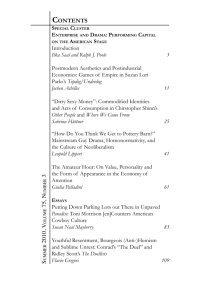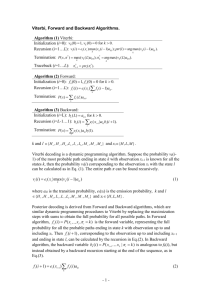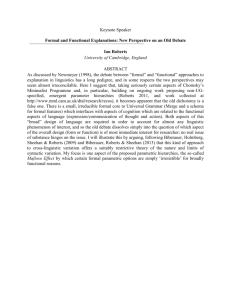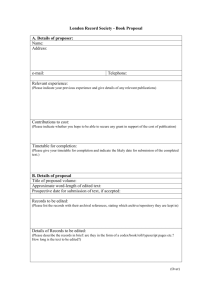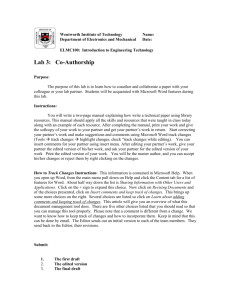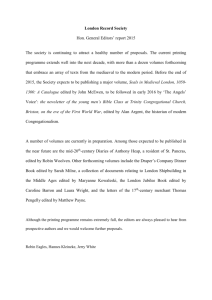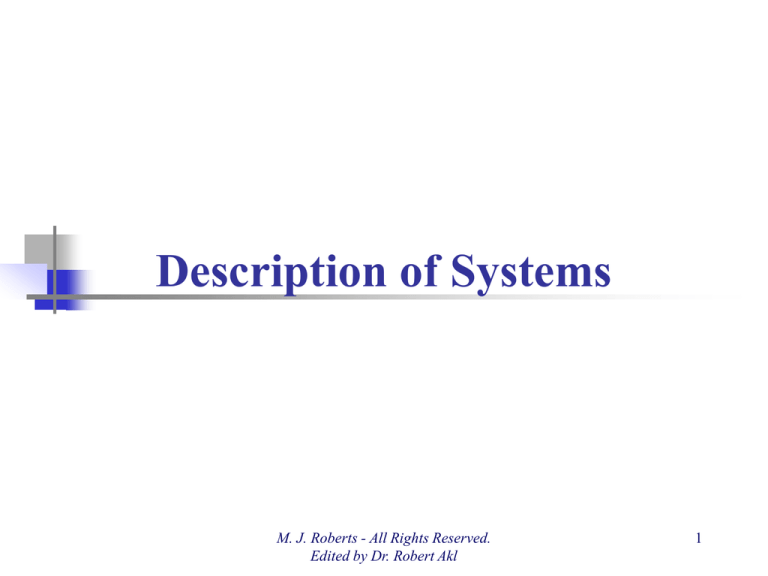
Description of Systems
M. J. Roberts - All Rights Reserved.
Edited by Dr. Robert Akl
1
Systems
• Broadly speaking, a system is anything that
responds when stimulated or excited
• The systems most commonly analyzed by
engineers are artificial systems designed and
built by humans
• Engineering system analysis is the
application of mathematical methods to the
design and analysis of systems
M. J. Roberts - All Rights Reserved. Edited by Dr. Robert Akl
2
System Examples
M. J. Roberts - All Rights Reserved. Edited by Dr. Robert Akl
3
Feedback Systems
In a feedback system the response of the system is “fed back”
and combined with the excitation is such a way as to optimize
the response in some desired sense. Examples of feedback
systems are
1. Temperature control in a house using a thermostat
2. Water level control in the tank of a flush toilet.
3. Pouring a glass of lemonade to the top of the glass without
overflowing.
4. A refrigerator ice maker which keeps the bin full of ice
but does not make extra ice.
5. Driving a car.
M. J. Roberts - All Rights Reserved. Edited by Dr. Robert Akl
4
Systems
• Systems have inputs and outputs
• Systems accept excitations or input signals
at their inputs and produce responses or
output signals at their outputs
• Systems are often usefully represented by
block diagrams
A single-input, single-output system block diagram
M. J. Roberts - All Rights Reserved. Edited by Dr. Robert Akl
5
A Multiple-Input, MultipleOutput System Block Diagram
M. J. Roberts - All Rights Reserved. Edited by Dr. Robert Akl
6
Block Diagram Symbols
Three common block diagram symbols for an amplifier (we will
use the last one).
Three common block diagram symbols for a summing junction
(we will use the first one).
M. J. Roberts - All Rights Reserved. Edited by Dr. Robert Akl
7
Block Diagram Symbols
Block diagram symbol for an integrator
M. J. Roberts - All Rights Reserved. Edited by Dr. Robert Akl
8
An Electrical Circuit Viewed as a
System
An RC lowpass filter is a simple electrical system.
It is excited by a voltage vin ( t ) and responds with a
voltage vout ( t ) . It can be viewed or modeled as a
single-input, single-output system
M. J. Roberts - All Rights Reserved. Edited by Dr. Robert Akl
9
Zero-State Response of an RC
Lowpass Filter to a Step Excitation
If an RC lowpass filter with an initially uncharged capacitor is
()
()
excited by a step of voltage v in t = Au t its response is
()
(
) ()
v out t = A 1- e-t / RC u t . This response is
called the zero - state response of this system
because there was initially no energy stored in
the system. (It was in its zero-energy state.)
If the excitation is doubled, the zero-state
response also doubles.
M. J. Roberts - All Rights Reserved. Edited by Dr. Robert Akl
10
Zero-Input Response of an RC
Lowpass Filter
If an RC lowpass filter has an initial charge on the capacitor
of V0 volts and no excitation is applied to the system its zero -
()
input response is v out t = V0 e-t / RC , t > 0.
M. J. Roberts - All Rights Reserved. Edited by Dr. Robert Akl
11
Homogeneity
• In a homogeneous system, multiplying the
excitation by any constant (including complex
constants), multiplies the zero-state response by the
same constant.
M. J. Roberts - All Rights Reserved. Edited by Dr. Robert Akl
12
Homogeneity
M. J. Roberts - All Rights Reserved. Edited by Dr. Robert Akl
13
Homogeneity
Let y ( t ) = exp ( x ( t ) ) . Is this system homogeneous?
Let x ( t ) = g ( t ) . Then y ( t ) = exp ( g ( t ) ) .
Let x ( t ) = K g ( t ) . Then y ( t ) = exp ( K g ( t )) = éexp ( g ( t )) ù
ë
û
K y ( t ) = K exp ( g ( t )) Þ y ( t ) ¹ K y ( t ) , Not homogeneous
1
1
K
2
2
1
2
1
() ()
Let x ( t ) = g ( t ) . Then y ( t ) = g ( t ) + 2.
Let x ( t ) = K g ( t ) . Then y ( t ) = K g ( t ) + 2
K y ( t ) = K g ( t ) + 2K Þ y ( t ) ¹ K y ( t ) , Not homogeneous
Let y t = x t + 2. Is this system homogeneous?
1
1
2
1
2
2
1
M. J. Roberts - All Rights Reserved. Edited by Dr. Robert Akl
14
Time Invariance
• If an excitation causes a zero-state response and
delaying the excitation simply delays the zerostate response by the same amount of time,
regardless of the amount of delay, the system is
time invariant.
If g(t) ¾H¾® y1 ( t ) and g(t - t 0 ) ¾H¾® y1 ( t - t 0 ) Þ H is Time Invariant
This test must succeed for any g and any t 0 .
M. J. Roberts - All Rights Reserved. Edited by Dr. Robert Akl
15
Time Invariance
Let y ( t ) = exp ( x ( t ) ) . Is this system time invariant?
Let x ( t ) = g ( t ) . Then y ( t ) = exp ( g ( t ) ) .
Let x ( t ) = g ( t - t ) . Then y ( t ) = exp ( g ( t - t ))
y ( t - t ) = exp ( g ( t - t )) Þ y ( t ) = y ( t - t ) , Time Invariant
1
1
2
1
0
2
0
0
0
2
1
0
() ( )
Let x ( t ) = g ( t ) . Then y ( t ) = g ( t / 2 ) .
Let x ( t ) = g ( t - t ) . Then y ( t ) = g ( t / 2 - t )
y ( t - t ) = g (( t - t ) / 2 ) Þ y ( t ) ¹ y ( t - t ) , Time Variant
Let y t = x t / 2 . Is this system time invariant?
1
1
2
1
0
0
2
0
2
0
1
0
M. J. Roberts - All Rights Reserved. Edited by Dr. Robert Akl
16
Additivity
If one excitation causes a zero-state response and another excitation
causes another zero-state response and if, for any arbitrary
excitations, the sum of the two excitations causes a zero-state
response that is the sum of the
two zero-state responses, the
system is said to be additive.
If g(t) ¾H¾® y1 ( t ) and h(t) ¾H¾® y 2 ( t )
and g ( t ) + h ( t ) ¾H¾® y1 ( t ) + y 2 ( t ) Þ H is Additive
M. J. Roberts - All Rights Reserved. Edited by Dr. Robert Akl
17
Additivity
( ) ( ( ))
Let x ( t ) = g ( t ) . Then y ( t ) = u ( g ( t ) ) .
Let x ( t ) = h ( t ) . Then y ( t ) = u ( h ( t ) ) .
Let x ( t ) = g ( t ) + h ( t ) . Then y ( t ) = u ( g ( t ) + h ( t ))
y ( t ) + y ( t ) = u ( g ( t ) ) + u ( h ( t ) ) ¹ u ( g ( t ) + h ( t ) ) . Not additive.
(For example, at time t = 3, if g ( 3) = 4 and h ( 3) = 2,
y ( 3) + y ( 3) = u ( 4 ) + u ( 2 ) = 1+ 1 = 2. But y ( 3) = u ( 4 + 6 ) = 1.)
Let y t = u x t . Is this system additive?
1
1
2
2
3
3
1
2
1
2
3
M. J. Roberts - All Rights Reserved. Edited by Dr. Robert Akl
18
Linearity and LTI Systems
• If a system is both homogeneous and additive
it is linear.
• If a system is both linear and time-invariant it
is called an LTI system
• Some systems which are non-linear can be
accurately approximated for analytical
purposes by a linear system for small
excitations
M. J. Roberts - All Rights Reserved. Edited by Dr. Robert Akl
19
Linearity and LTI Systems
In an LTI system, the analysis of the effect of an excitation
on a system can be found by breaking the excitation into pieces,
finding the responses to those pieces individually and then adding
()
( )
()
those responses. Let x t = rect t / 4 . We could break x t
(
) ( )
( )
0.25rect ( t / 4 ) or into any other convenient sum of functions that
equals x ( t ) .
into u t + 2 - u t - 2 or we could break it into 0.75rect t / 4 +
M. J. Roberts - All Rights Reserved. Edited by Dr. Robert Akl
20
Stability
• Any system for which the response is
bounded for any arbitrary bounded excitation,
is called a bounded-input-bounded-output
(BIBO) stable system
• A continuous-time LTI system described by a
differential equation is stable if the
eigenvalues of the solution of the equation all
have negative real parts
M. J. Roberts - All Rights Reserved. Edited by Dr. Robert Akl
21
Causality
• Any system for which the zero-state response
occurs only during or after the time in which
the excitation is applied is called a causal
system.
• Strictly speaking, all real physical systems are
causal
M. J. Roberts - All Rights Reserved. Edited by Dr. Robert Akl
22
Memory
• If a system’s zero-state response at any arbitrary
time depends only on the excitation at that same
time and not on the excitation or response at any
other time it is called a static system and is said to
have no memory. All static systems are causal.
• A system whose zero-state response at some
arbitrary time depends on anything other than
the excitation at that same time is called a dynamic
system and is said to have memory
• Any system containing an integrator has memory
M. J. Roberts - All Rights Reserved. Edited by Dr. Robert Akl
23
Static Non-Linearity
• Many real systems are non-linear because the
relationship between excitation amplitude and
response amplitude is non-linear
V-I Diagram for a
Linear Resistor
V-I Diagram for a Diode
M. J. Roberts - All Rights Reserved. Edited by Dr. Robert Akl
24
Static Non-Linearity
• For an analog multiplier, if the two excitations are the same
single excitation signal, the response signal is the square of
that single excitation signal and doubling the excitation
would cause the response to increase by a factor of 4
• Such a system is not homogeneous and therefore not linear
M. J. Roberts - All Rights Reserved. Edited by Dr. Robert Akl
25
Invertibility
A system is said to be invertible if unique
excitations produce unique zero-state responses. In
other words, if a system is invertible, knowledge of
the zero-state response is sufficient to determine the
excitation
This full-wave rectifier is
a non-invertible system
M. J. Roberts - All Rights Reserved. Edited by Dr. Robert Akl
26
Dynamics of Second-Order
Systems
The eigenfunction of an LTI system is the complex exponential.
The eigenvalues of a second-order system are either both real or
occur in a complex-conjugate pair. The general solution form is
a sum of two complex exponentials and a constant. For example,
the capacitor voltage in a series RLC circuit excited by a voltage
step of height A is
()
v out t = K1e
æ - a + a 2 -w 2 ö t
nø
è
+ K2e
æ - a - a 2 -w 2 ö t
nø
è
+A
where a = R / 2L and w n2 = 1 / LC. a is the damping factor and
w n is the natural radian frequency.
M. J. Roberts - All Rights Reserved. Edited by Dr. Robert Akl
27
Dynamics of Second-Order
Systems
The solution form K1e
æ - a + a 2 -w 2 ö t
nø
è
+ K2e
æ - a - a 2 -w 2 ö t
nø
è
applies
to all second-order LTI systems. It can also be written as
- a + jw c )t
- a - jw c )t
K e(
+ K e(
where w = w 1- z 2 and w
1
2
c
n
c
is the critical radian frequency and z = a / w n is the
damping ratio.
M. J. Roberts - All Rights Reserved. Edited by Dr. Robert Akl
28
Complex Sinusoid Excitation
Any LTI system excited by a complex sinusoid responds with
another complex sinusoid of the same frequency but generally
a different magnitude and phase. In the case of the RLC circuit
if the excitation is vin ( t ) = Ae j 2 p f0t the response is vout ( t ) = Be j 2 p f0t
where A and B are, in general, complex. B can be found by
substituting the solution form into the differential equation and
finding the particular solution. In the RLC circuit
A
B=
2
( j2p f0 ) LC + j2p f0 RC + 1
M. J. Roberts - All Rights Reserved. Edited by Dr. Robert Akl
29
Discrete-Time Systems
• With the increase in speed and decrease in
cost of digital system components, discretetime systems have experienced, and are still
experiencing, rapid growth in modern
engineering system design
• Discrete-time systems are usually described
by difference equations
M. J. Roberts - All Rights Reserved. Edited by Dr. Robert Akl
30
Block Diagram Symbols
The block diagram symbols for a summing junction and an
amplifier are the same for discrete-time systems as they are
for continuous-time systems.
Block diagram symbol for a delay
M. J. Roberts - All Rights Reserved. Edited by Dr. Robert Akl
31
Discrete-Time Systems
In a discrete-time system events occur at points in time but not
between those points. The most important example is a digital
computer. Significant events occur at the end of each clock
cycle and nothing of significance (to the computer user) happens
between those points in time.
Discrete-time systems can be described by difference (not
differential) equations. Let a discrete-time system generate an
excitation signal y[n] where n is the number of discrete-time
intervals that have elapsed since some beginning time n = 0.
Then, for example a simple discrete-time system might be
described by
y [ n ] = 1.97 y [ n - 1] - y [ n - 2]
M. J. Roberts - All Rights Reserved. Edited by Dr. Robert Akl
32
Discrete-Time Systems
The equation
y [ n ] = 1.97 y [ n - 1] - y [ n - 2 ]
says in words
“The signal value at any time n is 1.97 times the signal value at the
previous time [ n - 1] minus the signal value at the time before that
[ n - 2 ].”
If we know the signal value at any two times, we can compute its
value at all other (discrete) times. This is quite similar to a
second-order differential equation for which knowledge of two
independent initial conditions allows us to find the solution for all
time and the solution methods are very similar.
M. J. Roberts - All Rights Reserved. Edited by Dr. Robert Akl
33
Discrete-Time Systems
M. J. Roberts - All Rights Reserved. Edited by Dr. Robert Akl
34
Discrete-Time Systems
y [ n ] = 1.97 y [ n - 1] - y [ n - 2 ]
With the initial conditions y [1] = 1 and y [ 0 ] = 0 the (zero-
input) response is y [ n ] .
M. J. Roberts - All Rights Reserved. Edited by Dr. Robert Akl
35
Solving Difference Equations
On the previous two slides we found the solution to
y [ n ] = 1.97 y [ n - 1] - y [ n - 2 ]
by iteration as a sequence of numbers for y [ n ] . We can also solve
linear, constant-coefficient ordinary difference equations with techniques
that are very similar to those used to solve linear, constant-coefficient
ordinary differential equations. The eigenfunction of this type of equation
is the complex exponential z n . As a first example let the equation be
2 y [ n ] - y [ n - 1] = 0. The homogeneous solution of this equation is
then y h [ n ] = Kz n . Substituting that into the equation we get
2Kz n - Kz n-1 = 0. This is the characteristic equation. Dividing
through by Kz n -1 we get 2z - 1 = 0 and the solution is z = 1 / 2.
M. J. Roberts - All Rights Reserved. Edited by Dr. Robert Akl
36
Solving Difference Equations
The eigenvalue for the equation 2 y [ n ] - y [ n - 1] = 0 is then z = 1 / 2
and the homogeneous solution is y h [ n ] = K (1 / 2 ) . Since the equation
n
is homogeneous, the homogeneous solution is also the total solution.
To find K we need an initial condition. Let it be y [ 0 ] = 3. Then
y [ 0 ] = K (1 / 2 ) = K = 3 and y [ n ] = 3(1 / 2 ) .
0
n
M. J. Roberts - All Rights Reserved. Edited by Dr. Robert Akl
37
Solving Difference Equations
The solution of inhomogeneous equations is also similar to
differential equation techniques. Let 5y [ n ] - 3y [ n - 1] = (1 / 3) with
n
an initial condition of y [ 0 ] = -1. The characteristic equation is
5z - 3 = 0. The eigenvalue is 3 / 5 and the homogeneous solution is
y h [ n ] = K ( 3 / 5 ) . The particular solution is a linear combination of
n
the forcing function (1 / 3) and all its unique differences. The first
n
backward difference of (1 / 3) is (1 / 3) - (1 / 3)
n
n
n-1
, which can be written
as - 2 (1 / 3) . This is just the same function but with a different
n
multiplying constant. So the first difference of an exponential is also
an exponential. Therefore the only functional form we need for the
particular solution is K p (1 / 3) .
n
M. J. Roberts - All Rights Reserved. Edited by Dr. Robert Akl
38
Solving Difference Equations
Substituting the particular solution form into the difference equation
we get 5K p (1 / 3) - 3K p (1 / 3)
n
n-1
= (1 / 3) . Solving,
n
n
1 / 3)
1/ 3
(
Kp =
= -1 / 4. Then the total
n
n-1 =
5 (1 / 3) - 3
5 (1 / 3) - 3(1 / 3)
n
n
solution is y [ n ] = K ( 3 / 5 ) - (1 / 4 ) (1 / 3) . Applying initial
0
0
conditions y [ 0 ] = K ( 3 / 5 ) - (1 / 4 ) (1 / 3) = K - 1 / 4 = -1
Therefore K = -3 / 4 and the total solution is
y [ n ] = ( -3 / 4 ) ( 3 / 5 ) - (1 / 4 ) (1 / 3) .
n
M. J. Roberts - All Rights Reserved. Edited by Dr. Robert Akl
n
39
A System
If the excitation x[n] is the unit sequence, the zero-state
response is
n
y [ n ] = éë 5 - 4 ( 4 / 5 ) ùû u [ n ]
M. J. Roberts - All Rights Reserved. Edited by Dr. Robert Akl
40
A System
If the excitation is doubled, the zero-state response doubles.
If two signals are added to form the excitation, the zero-state
response is the sum of the zero-state responses to those two
signals. If the excitation is delayed by some time, the zero-state
response is delayed by the same time. This system is linear and
time invariant.
M. J. Roberts - All Rights Reserved. Edited by Dr. Robert Akl
41
System Properties
• The properties of discrete-time systems have
the same meaning as they do in continuoustime systems
M. J. Roberts - All Rights Reserved. Edited by Dr. Robert Akl
42
Eigenfunctions of LTI Systems
• The eigenfunction of an LTI system is the
complex exponential
• The eigenvalues are either real or, if
complex, occur in complex conjugate pairs
• Any LTI system excited by a complex
sinusoid responds with another complex
sinusoid of the same frequency, but generally
a different amplitude and phase
• All these statements are true of both
continuous-time and discrete-time systems
M. J. Roberts - All Rights Reserved. Edited by Dr. Robert Akl
43

